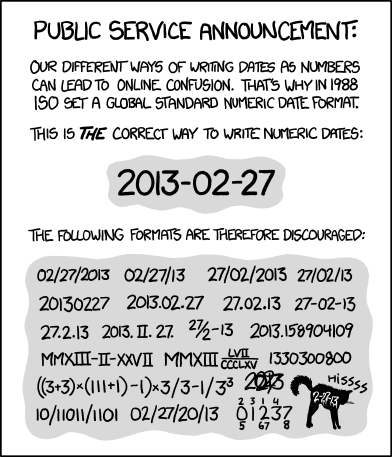
Life before lubridate was so hard.
We will not even venture down this road.
When you encounter non-lubridate date code, be strong.
Ranae Dietzel & Andee Kaplan
lubridate
Life before lubridate was so hard.
We will not even venture down this road.
When you encounter non-lubridate date code, be strong.

xckd.com
Getting R to recognize a date is usually the first step
dates<-c("10/20/2016", "10/21/2016", "10/22/2016")
mdy(dates)## [1] "2016-10-20" "2016-10-21" "2016-10-22"Now we are good.
parse_date_timeparse_date_time("2014-09-24 15:23:10", orders="ymd hms") ## [1] "2014-09-24 15:23:10 UTC"parse_date_time("09/24/2014 15-23-10", orders="mdy hms")## [1] "2014-09-24 15:23:10 UTC"parse_date_time("24 09 2014 15 23 10", orders="dmy hms")## [1] "2014-09-24 15:23:10 UTC"parse_date_time("24-09-14 15-23-10", orders="dmy hms")## [1] "2014-09-24 15:23:10 UTC"parse_date_time("Sep 24, 2014 15:23:10", orders="mdy hms")## [1] "2014-09-24 15:23:10 UTC"month("2016-10-21")## [1] 10day("2016-10-21")## [1] 21year("2016-10-21")## [1] 2016yday("2016-10-21")## [1] 295yday(mdy(dates))## [1] 294 295 296For example, when can Andee prepare for her prelim?
now<-Sys.time()
prelim<-"2016-10-25 09:00:00 CDT"
prep<-now %--% prelim
prep## [1] 2016-10-21 14:58:35 UTC--2016-10-25 09:00:00 UTCWhen will Ranae be at a Software Carpentry Instructor workshop?
depart<-"2016-10-23 12:00:00 CDT"
return<-"2016-10-25 20:00:00 CDT"
workshop<- depart %--% return
workshop## [1] 2016-10-23 12:00:00 UTC--2016-10-25 20:00:00 UTCWill Andee and Ranae be occupied at the same time?
int_overlaps(prep, workshop)## [1] TRUEWhen will Andee and Ranae both be unavailable?
setdiff(prep, workshop)## [1] 2016-10-21 14:58:35 UTC--2016-10-23 12:00:00 UTC
The length of months and years change so often that doing arithmetic with them can be unintuitive. Consider a simple operation, January 31st + one month. Should the answer be
Lubridate does arithmetic with dates, but you still have to think about it and make decisions about what you really mean and want.
However, there are helpful functions such as:
How long does Andee have to prepare for her prelim?
as.period(prep %% months(1))## [1] "3d 18H 1M 24.9760739803314S"